The weather in Taiwan in early June was sultry and unstable, with frequent rain. We checked the weather reports every day and frowned, as we were used to living in Southern California, where it rarely rains. We wanted to take advantage of our rare time in Taiwan to explore as much as possible, but we hesitated to go out due to the rainy forecast.
After chatting with friends who live in Taiwan year-round, I found that they were used to the rainy season — to them, it was simply a matter of bringing an umbrella. So, we decided to go out and try our luck. During those days, we visited several tourist attractions in Tamsui. To document our recent visits, I will intersperse this article with some older photos of Tamsui.
六月初台灣的天氣悶熱不穩定,常下雨,我們每天對著氣象報告愁眉苦臉,因為我們在少雨的南加州住慣了。我們想藉著難得在臺灣的日子到處探索,一看到下雨的預報便怯步不前。
但與常年住臺灣的朋友聊天,發現他們習慣這種多雨的季節,對他們來說好歹就是帶把傘就罷了。想想我們也就決定出門試試運氣。那些天住淡水,便探訪幾個淡水的景點。為了記錄近來遊覽淡水的景點,在這篇會穿叉一些舊照片。
History 歷史
Tamsui District, formerly known as Huwei, is located in the northwest of New Taipei City, Taiwan, on the north bank of the lower reaches of the Tamsui River, the third-longest river in Taiwan. The coast at the Tamsui River estuary was once a stop on the Southeast Asian sea route, and Datun Mountain served as an excellent navigational landmark. As a result, early inhabitants lived tribal lives centered on fishing, hunting, and farming.
The indigenous Ketagalan people frequently interacted with ships from Southeast Asia, East Asia, the Japanese archipelago, and the Ryukyu Islands, conducting bartering activities along the riverbanks. Starting in the 16th century, Taiwan's strategic geographic location attracted the attention of Western maritime powers. To maintain control over the Philippines and counter the Dutch, British, and Portuguese, the Spanish occupied Keelung in 1628 and built Fort San Domingo near what is today known as Fort Red Hair (Hongmaocheng) in Tamsui.
In 1642, the Dutch, who were then ruling southern Taiwan, moved north and expelled the Spanish. They rebuilt the fort near the original site and named it Fort Antonio (now Fort San Domingo/Fort Red Hair). The fort became a hub for the transportation and trade of sulfur, deerskin, and local products. Tamsui also served as a port for trading with merchants from Southeast Asia, East Asia, and the Japanese Islands.
In 1661, Zheng Chenggong (Koxinga) crossed the sea and expelled the Dutch. By this time, Huwei (Tamsui) had gradually evolved from a small fishing village into a prosperous settlement and a relatively large trading port.
Following the signing of the Treaty of Tianjin in 1858, Tamsui officially opened its port. Foreign ships were only permitted to trade at designated treaty ports, and trade at other ports was considered smuggling. In 1862, tariffs were formally imposed in Tamsui, and it became the largest trading port in Taiwan. The area attracted numerous foreign businesses and missionaries, who developed the region and constructed many Western-style buildings, giving Tamsui a unique and exotic cultural landscape.
During the Japanese occupation, as the Tamsui River gradually became too shallow for large vessels, Keelung Port and railway connections between Taipei and Keelung were developed, eventually replacing Tamsui as the primary trading port.
Since the 1990s, with the development of Danhai New Town, various transportation infrastructure projects have been implemented, making Tamsui an emerging area of population growth on the outskirts of the Taipei Metropolitan Area.
淡水區,舊稱虎尾,位於台灣新北市西北部,全台第三長的淡水河下游北岸。淡水河口沿岸曾是東南亞海上航線的停靠點,大屯山又是重要的航海地標。因此早期居民在此過著以漁獵農耕為主的部落生活。
原住民凱達格蘭族經常與來自東南亞、東亞、日本群島和琉球群島的船隻頻繁往來,沿著河岸進行以物易物貿易。自16世紀起,台灣的戰略地理位置吸引了西方海權強國的注意。為了控制菲律賓並對抗荷蘭、英國和葡萄牙,西班牙人於 1628 年佔領基隆,並在如今淡水紅毛城古蹟區附近建造聖多明哥城(San Domingo)。
1642 年,當時統治台灣南部的荷蘭人北上,驅逐了西班牙人。他們在原址附近重新築城,名為安東尼堡(Fort Antonio,今紅毛城)。這座城堡成為了硫磺、鹿皮和當地特產的運輸和貿易樞紐。淡水也曾是與東南亞、東亞和日本列島商人進行貿易的港口。
1661 年,鄭成功渡海驅逐荷蘭人,此時的虎尾(淡水)已由一個小漁村逐漸發展成為一個繁榮的聚落和較大的貿易通商港口。
1858 年《天津條約》簽訂後,淡水正式開港。當時,外國船隻只能在指定的通商口岸通商,其他港口的貿易則被視為走私。 1862 年,淡水正式徵收關稅,成為台灣最大的通商港口。吸引了眾多外國商人和傳教士,他們在此開發,建造了許多西式建築,使淡水形成了獨特而充滿異國風情的人文景觀。
日治時期,因淡水河河道日漸淤淺,大型船舶出入不便,乃積極建設基隆港及台北與基隆之間的鐵路連接,逐漸取代淡水成為主要貿易港口。
1990 年代起,隨著淡海新市鎮的發展,各項交通建設逐步推動,使淡水成為台北都會區邊緣新興的人口增長區。
Tamsui Golden Anchor 淡水金色水岸
Tamsui Golden Anchor is named after the golden waves created by the setting sun reflecting on the Tamsui River. After exiting Tamsui MRT Station, turn left and walk toward Tamsui Old Street. On one side, along the Tamsui River, you can enjoy views of Guanyin Mountain and the estuary. On the other side, there are many shops, and it's quite enjoyable to browse through those selling unique items.
淡水金色水岸因夕陽西下時淡水河泛起的金色波光而得名。出淡水捷運站後左轉,向淡水老街步行即可抵達。一邊沿著淡水河畔,可以欣賞到對岸的觀音山和河口的景色。另一邊,商店林立,逛逛那些販售特色商品的店鋪,也是一大享受。




George Leslie Mackay 馬偕
Mackay has a deep connection with Tamsui. Born in 1844, George Leslie Mackay came to Tamsui as a missionary in 1872. Guided by the belief that "Everything is for Christ," he devoted his life to missionary work, medical care, and education in Taiwan. As a result, sculptures, buildings, and street names related to Mackay are often seen throughout Tamsui.
- Missionary work: Mackay began preaching just one month after arriving in Tamsui. In 1872, he established the first church in northern Taiwan. He learned conversational Hokkien from a servant and a cowherd boy, and within five months, he was able to preach in Taiwanese. Over seven years, he established 20 churches in the area north of the Dajia River and trained 22 local missionaries. Although Mackay worked diligently, his efforts were not always met with support. He faced opposition, including the destruction of houses and people throwing stones at him. However, he remained undeterred, relying on patience, courage, and medical care to win over believers. After 1883, he shifted his missionary focus to Yilan, Hualien, and other regions inhabited by Indigenous peoples (including the Kavalan and Pingpu peoples), where he also established churches. During his thirty years in Taiwan, Mackay founded more than 60 churches.
- Medical care: Although Mackay was not a doctor, he had studied anatomy and physiology. While serving as a missionary in Tamsui, he began providing free medical care, helped people with dental issues, distributed malaria medicine, and educated the public about hygiene and health. He spread the gospel through these practical services, which led to a growing number of converts. With support from friends in the Western world, Mackay founded the Ho-be Mackay Hospital in 1880—northern Taiwan’s first Western-style hospital—located in what is now Tamsui District. This institution later evolved into Mackay Memorial Hospital, which remains one of the most renowned hospitals in Taiwan today.
- Education: During his missionary work in Taiwan, Mackay emphasized the cultivation of local talent to carry on religious missions. He also placed great importance on education. In 1882, he founded "Oxford College," now known as Aletheia University. The school offered Bible studies, theology, and various sciences, along with fieldwork and medical internships, making for a well-rounded education. Recognizing that Taiwanese society at the time prioritized boys over girls and that most women were illiterate, Mackay also founded Taiwan's first girls’ school—Tamsui Girls' School—in 1884, pioneering education for girls in the region.
馬偕與淡水有很深的淵源。生於 1844 年的馬偕,在 1872 年來到淡水宣教,背負著「一切都是為了基督」的情懷,將畢生心力貢獻在台灣的傳教、醫療與教育上。因而在淡水常會看到與馬偕有關的雕塑、建築物以及街名。
- 傳教: 馬偕抵達淡水僅一個月後便開始佈道。 1872 年,他在台灣北部建立了第一座教堂。他從僕人和牧牛童那裡學會了閩南語,而五個月後能用台語傳道。在七年間,他在大甲溪以北地區設立了 20 間教會,並培訓了 22 位當地傳教士。儘管馬偕竭盡心力從事宣教活動並不都是一直一帆風順。他有遭遇到房屋被拆以及被人擲石反對他傳教的事情。然而,他並不氣餒,憑藉耐心、勇氣及替民眾醫病來爭取信徒。 1883 年後,他將傳教重心轉移到宜蘭、花蓮和其他原住民(包括噶瑪蘭族和平埔族)居住的地區,並在那裡建立了教堂。在台灣的三十年間,馬偕設立了 60 多座教堂。
- 醫療: 馬偕雖然並非醫生,但他曾研讀解剖學和生理學。在淡水傳教時,他開始提供免費醫療,幫人拔除蛀牙,贈送瘧疾特效藥,並教導民眾公共衛生知識。他透過這些務實的服事來傳福音,使歸信的人數與日俱增。在西方朋友的支持下,馬偕於 1880 年在今日的淡水區創辦了台灣北部第一所西醫醫院-滬尾偕醫館。這家醫院後來發展成為馬偕紀念醫院,至今仍是台灣最著名的醫院之一。
- 教育: 馬偕在台傳教期間,注重培養本地人成為宣教人才。他也十分重視教育。 1882 年,他創辦了「牛津學堂」即「理學堂大書院」(今真理大學)。學校除課堂教授聖經、神學及各種科學課程外,並提供田野調查和醫學實習,教學多元活潑旨在提供全面的教育。馬偕意識到當時台灣社會重男輕女、女性大多是文盲,於是於 1884 年創辦了台灣第一所女子學校——「淡水女學堂」,開創了女子教育的先河。
Sculpture of Mackay 馬偕紀念雕塑
In 1995, New Taipei City invited Professor Zhang Zilong, a sculptor from Tamsui, to create a commemorative sculpture of Mackay. It is located in the roundabout at the intersection with Mackay Street.
1995 年新北市邀請淡水雕塑家張子隆教授著手為馬偕創作紀念雕塑,這雕像位於馬偕街街口的圓環。


Bronze statue of Mackay 馬偕藝術銅像
The artistic bronze statue of Mackay, marking the spot where he first landed, is located on the riverbank behind the Tamsui Post Office. It was created by Mr. Chen Kaihuang of the National Taipei University of the Arts. The statue depicts Dr. Mackay kneeling in front of a boat in prayer, expressing his gratitude to God.
馬偕上岸處的馬偕藝術銅像位於淡水郵局後方河岸處,由國立臺北藝術大學陳愷璜先生所作,銅像為馬偕博士跪在船前的地面上禱告,以示感恩上帝。


Ho-be MacKay Hospital 滬尾偕醫館
Ho-be MacKay Hospital was designed by Mackay himself and built by plasterer Hong Quanshi in 1880. The building combines Chinese and Western architectural styles, featuring Western-style round-arched windows and a Minnan-style tile roof. The outer foundation wall is surrounded by Qilian stone, and staircases are located on both sides. It is now a designated historic site in New Taipei City. Today, Ho-be Mackay Hospital still retains its original appearance, and some of the medical equipment used by Dr. Mackay during his practice is still preserved inside.
位於馬偕街 6 號的滬尾偕醫館為馬偕親自設計,泥水匠洪泉師在 1880 年所興建,這醫館乃是中西合併的樣式,有西式的圓拱窗和閩南瓦的屋頂,基礎外垣圍唭哩岸石材,階梯採雙邊設計。現為新北市市定古蹟。目前醫館仍保持初建之樣貌,館內並保有一些馬偕博士行醫時之醫療器材。


Tamsui Chapel 淡水禮拜堂
The early Tamsui Chapel was originally a house rented by Mackay in 1872, used for preaching the gospel and practicing medicine. It was later renovated from the doctor’s dormitory of the Ho-be Mackay Hospital. After Mackay’s death in 1901, Tamsui Church entered a new era. Due to practical needs and the need for expansion, and after several reconstructions, the current chapel was designed and completed in 1933 by Pastor George William Mackay, Mackay’s son.
The symbol of the Presbyterian Church in Taiwan, "Burning but not destroyed," comes from Exodus Chapter 3 in the Old Testament. It symbolizes that although God's people may suffer, God protects them and remains with them. During the Qing-French War in 1884, seven churches were affected by xenophobic sentiment and were burned down by angry locals. During the reconstruction of the churches, Mackay adopted this symbol to represent that the Taiwanese church had emerged from persecution and hardship.
It was designated a Taipei County Historic Site in 1998 and is now recognized as a New Taipei City Municipal Historic Site.
The exterior of the building is designed in an imitation Gothic style. The "Trinity" on the front of the church, the "Five Loaves and Two Fishes" on the bell tower, and the "Prayer in the Garden of Gethsemane" stained glass windows add an elegant atmosphere to the chapel.
The Gospel Bell next to the main entrance has been in place since 1915. During the Second World War, it was requisitioned by the Japanese government to be used as an air raid siren and was installed on the roof of the Tamsui Red Building. It was later damaged during an air raid. After the war, the bell was returned to the church and officially named the "Gospel Bell" in 1985.
初期的淡水禮拜堂乃 1872 年馬偕承租的房子,用來佈道及行醫,後來則是由偕醫館的醫師宿舍改建而成。1901年馬偕去世後,淡水教會進入了新的時代,由於實際及擴展需要,經過幾次改建後,現今樣貌的禮拜堂是 1933 年馬偕的兒子偕叡廉牧師所設計完成的。
象徵臺灣基督長老教會的標記「焚而不燬」,源自舊約聖經出埃及記第 3 章,象徵著上帝的子民雖處於苦難中,但上帝卻要保護他們,與其同在。1884 年清法戰爭時,陸續有 7 間教堂受到排外情緒的波及,遭本地憤怒民眾燒燬。在教堂重建時,馬偕用此標誌,代表著臺灣教會是從迫害、艱難的處境中洗鍊出來的。
淡水禮拜堂在 1998 年被指定為台北縣古蹟,現為新北市市定古蹟。
淡水禮拜建築外觀仿哥德式,教堂正面的「三位一體」、鐘樓的「五餅二魚」和「客西馬尼園禱告」的彩繪玻璃,給禮拜堂添加了典雅的氣氛。
正門旁的福音鐘自 1915 年即已存在,二次世界大戰期間,曾被日本政府徵用為警報器,架設於淡水紅樓屋頂,後因在空襲中遭受炸射而破裂,戰後此鐘被送回教會,1985 年取名「福音之鐘」。






Aletheia University 真理大學
Aletheia University originated from Oxford College, founded by Mackay in 1882. To carry on Dr. Mackay’s contributions to Taiwan’s culture, education, and medical care, the Northern Office of the Presbyterian Church in Taiwan established the Tamsui Institute of Business Administration on the original site in 1965. In 1994, it was approved to be transformed into a four-year college, and in 1999, it was renamed Aletheia University.
真理大學源自 1882 年馬偕創建的牛津學堂,北部台灣基督長老教會為繼承馬偕博士對台灣文化、教育、醫療的貢獻,於 1965 年在原址設立「私立淡水工商管理專科學校」,1994 年奉准改制為四年制獨立學院,1999 年改名為「真理大學」。

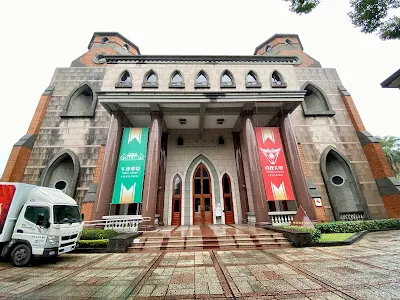
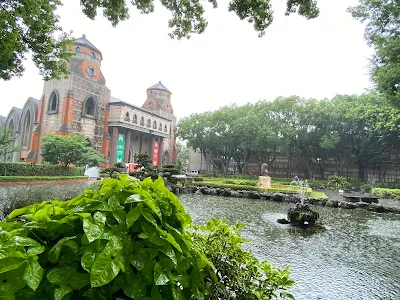
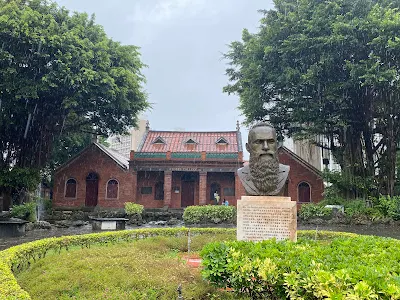




Fort Santo Domingo/Fort Red Hair/Hongmaocheng 紅毛城
Fort Santo Domingo was designated a national historic site by the Republic of China in 1983. The main fortress and the British Consul’s Residence on its east side have a long and complex history.
In 1624, the Dutch sought to establish a trading post in what is now Taiwan and frequently attacked Chinese ships, disrupting trade between the Spanish and the Chinese. In response, the Spanish decided to occupy Taiwan both to counter the Dutch and, as part of the Dominican Order, to begin missionary work in China and Japan.
In 1626, the Spanish occupied Jilong (Keelung) Island, and to secure more food supplies, they attacked the area now known as Tamsui. In 1628, they built a fortress in Tamsui as a stronghold, named it Fort Santo Domingo, and established a Catholic church beside it.
In 1636, local Indigenous people in Tamsui attacked Fort Santo Domingo, burned its walls to the ground, and destroyed four churches. Later, due to either insufficient military funding or defeat by the Dutch, the Spanish abandoned the fort and burned its remaining structures upon withdrawal.
In 1641, the Dutch began trading sulfur and deerskin with local residents in Tamsui. After occupying Jilong in 1642, they rebuilt a stronger fortress—Fort Antonio—near the original site of Fort Santo Domingo in 1644. Because the Han Chinese at the time referred to the Dutch as “Red-haired People,” Fort Antonio also became known as Fort Red Hair.
After Zheng Chenggong (Koxinga) defeated the Dutch, they completely withdrew from Taiwan in 1668. Upon evacuating Fort Red Hair, the Dutch destroyed the city walls and burned remaining supplies. In 1683, the Zheng regime formally surrendered to the Qing Dynasty. It wasn’t until 1724 that the Qing renovated the fort, adding new walls and four gates.
Following the signing of the Treaty of Tianjin in 1860 between China and Britain, Tamsui Port was opened to foreign trade. The British established a consulate in Tamsui in 1861 and signed a “Permanent Lease of Fort Red Hair” with the Qing government in 1867. After the consulate relocated, the fort underwent extensive repairs. Due to a sharp increase in trade at Tamsui Port, the British built a two-story red brick mansion in 1891 on the east side of the site as the official residence of the British consul.
Thus, Fort Red Hair transitioned from a military stronghold to an official diplomatic site, becoming a center for international exchange.
In 1895, Taiwan entered the period of Japanese rule, but Fort Red Hair continued to serve as the British Consulate. In 1941, after the outbreak of the Pacific War and Japan’s declaration of war on Britain and the United States, the consulate at Fort Red Hair was closed in December.
After World War II, Britain resumed control of Fort Red Hair based on the permanent lease agreement and reopened its consulate. Although the United Kingdom severed diplomatic relations with the Republic of China in 1950, the consulate in Tamsui continued to operate. It wasn't until 1972 that the UK officially withdrew from Fort Red Hair and entrusted its management to Australia, and later, to the United States.
In 1979, the United States also severed diplomatic relations with the Republic of China. The following year, the Ministry of Foreign Affairs of the Republic of China informed the United Kingdom that it would terminate the permanent lease and reclaim the land. In 1980, Fort Red Hair was officially handed over by the British to the government of the Republic of China.
紅毛城於 1983 年被中華民國指定為國家古蹟,其主堡與東側的英國領事館有著悠久而複雜的歷史。
1624 年,荷蘭人想在現今的台灣地區建立貿據點,經常劫掠中國船隻,擾亂了西班牙與中國之間的貿易。西班牙人便決定佔領臺灣以對抗荷蘭人,同時作為天主教道明會 (Dominican Order) 向中國及日本傳教的跳板。
1626年,西班牙人佔領雞籠(基隆)島,之後為了增加糧食的來源便攻打現今的淡水。 1628 年,他們在淡水築城作為據點,命名為聖多明哥堡,並在旁邊建立了一座天主教堂。
1636 年,淡水原住民攻佔紅毛城,將城砦焚毀,同時也摧毀四座教堂。其後,西班牙人或因軍費不足,或因敗於荷蘭之手,棄城而去,撤退時更焚毀城內殘存建築。
1641 年,荷蘭人開始與淡水當地居民進行硫磺和鹿皮貿易。 1642 年佔領雞籠(基隆)後,荷蘭人於 1644 年在聖多明哥城原址附近重建了一座更堅固的堡壘-安東尼奧堡。由於當時的漢人稱荷蘭人為“紅毛番”,安東尼奧堡也因此被稱為“紅毛城”。
鄭成功攻克臺灣後,1668 年荷蘭人自臺灣全數撤退。荷蘭人撤離紅毛城時,摧毀了城牆,焚燒了剩餘的物資。 1683 年,鄭成功正式向清朝投降。直到 1724 年,清朝才加以整修紅毛城,增建了城牆和四座城門。
1860 年中英簽訂《天津條約》,淡水港正式開放通商。英國於 1861 年在淡水設立領事館,並於 1867 年與清廷簽訂《紅毛城永久租約》。領事館遷址後,紅毛城進行了大規模修葺。由於淡水港貿易量激增,英國人於 1891 年在紅毛城東側建造了一座兩層式紅磚洋樓,作為英國領事官邸。
從此,紅毛城從軍事要塞轉型為官方外交據點,成為國際交流的中心。
1895 年,台灣進入日治時期,但紅毛城繼續作為英國領事館使用。 1941 年,太平洋戰爭爆發,日本對英美宣戰後,紅毛城領事館於 12 月關閉。
第二次世界大戰後,英國以永代租借權為由重返紅毛城,並復設領事館。雖然英國於 1950 年與中華民國斷絕外交關係,但淡水領事館仍維持業務。直到 1972 年,英國才正式撤出紅毛城,並將其託管給澳大利亞,後來又委託美國管理。
1979 年,美國也與中華民國斷絕外交關係。隔年,中華民國外交部通知英國,將終止永久租約並收回此地。 1980 年,紅毛城正式由英國移交給中華民國政府。
紅毛城九面旗幟代表著紅毛城三百餘年來的歷史演變過程,其歷經西班牙、荷蘭、明鄭、清朝、英國、日本、澳大利亞、美國、中華民國之管理或代管。




前英國領事官邸








Tamsui Customs Wharf 淡水海關碼頭
Tamsui Customs Wharf is located opposite Fort Red Hair (Fort Santo Domingo). During the Qing Dynasty, it became an important port in Taiwan due to the Treaty of Tianjin (1858) and the Treaty of Beijing (1860). After the British Vice Consul visited Taiwan for inspection in 1861, it was agreed to use Huwei (Tamsui) as a trading terminal. In 1862, the Qing government established a customs office there and officially began collecting taxes.
Customs under the Qing Dynasty were divided into Xinguan (new customs or foreign customs), which collected tariffs on goods crossing national borders, and Changguan (old customs or domestic customs), which collected taxes on goods traded within the country. Since new customs mainly dealt with foreign trade, they were managed by the Zongli Yamen (Office of Foreign Affairs). The British were appointed to oversee the General Taxation Department, transferring customs management rights to foreigners. A Deputy Taxation Department was also established to handle taxation at four major ports in Taiwan.
In 1863, British official John William Howell served as the first Deputy Taxation Officer. Foreigners began to be stationed in Huwei, which became the main customs station, with Jilong (Keelung), Dagou (Kaohsiung), and Anping serving as sub-stations. All tax records were submitted from Huwei Customs to Tianjin Customs.
The customs facilities in Huwei included the customs office area, the governor's official residence, and the dock area. Tamsui (Huwei) Customs was handed over to Japan in 1895. In 1916, the Tamsui Customs Office was relocated from Tamsui to Dadaocheng, Taipei, marking the end of Tamsui’s role as the center of Taiwan's customs affairs. The site was designated a county-level historic site in 2000.
淡水海關碼頭位於紅毛城對面。清朝時期,因《天津條約》(1858年)和《北京條約》(1860年)的簽訂,淡水海關碼頭成為台灣的重要港口。 1861 年,英國副領事來台視察,議定以滬尾(淡水)作為貿易碼頭。 1862 年,清政府在此設立海關,正式開始課稅。
清朝海關分為新關(即新海關或洋關)和常關(即舊海關或國內海關),新關負責徵收入境貨物的關稅,常關負責徵收境內貿易貨物的關稅。由於新海關主要處理對外貿易,因此由總理各國事務衙門(即外事辦)管理。總稅司由英國人管轄,海關管理權移交給外國人。此外,還設立了副稅司,負責管理台灣四個主要港口的稅務。
1863 年,英國官員豪威爾(John William Howell)出任首任副稅務官。洋人開始在滬尾駐紮,滬尾成為本關,基隆(基隆)、打狗(高雄)和安平則為分關。所有稅務記錄均由滬尾海關轉天津關庫。
滬尾海關設施包括海關關署區、長官官邸區及碼頭區。淡水(滬尾)海關於 1895 年移交給日本。 1916 年,淡水稅關總關從淡水移設台北大稻埕,標誌著淡水作為全臺關務的地位終結。該遺址於 2000 年被指定為縣級古蹟。










Tamsui Fisherman's Wharf 淡水漁人碼頭
Tamsui Fisherman's Wharf, formerly known as Tamsui Second Fishing Port, is a multifunctional leisure fishing port developed by the New Taipei City Government. The pier floats with the ebb and flow of the tide and can accommodate up to 150 fishing boats at the same time. The nearby landmark, Lover’s Bridge, is a popular spot for taking memorable photos.
淡水漁人碼頭,舊名淡水第二漁港,是新北市府近期開發成多功能的休閒漁港。這座碼頭隨潮汐漲落而浮動,最多可同時容納 150 艘漁船。附近的地標-情人橋,是打卡的熱門景點。
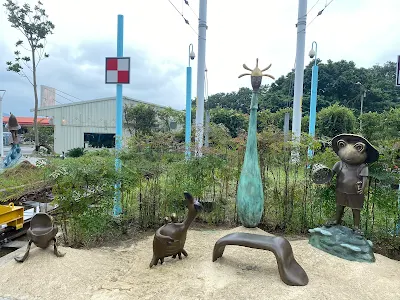











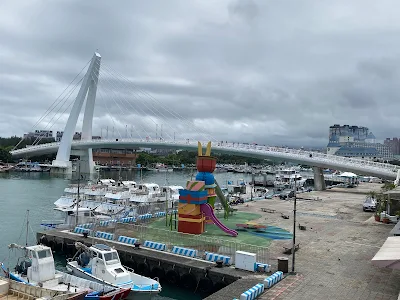






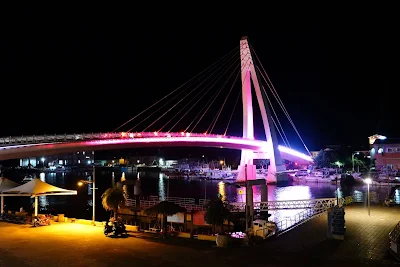








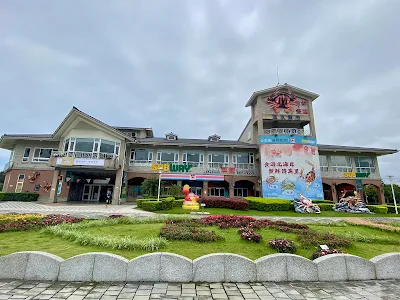

Shalun 沙崙
Shalun was once a haunt for sharks and green sea turtles, and it was also the site where French troops landed and fought at Huwei in 1884. A private bathing beach was established there in 1919 during the Japanese occupation. In 1959, it was jointly operated by the Tamsui District Office and the Taiwan Provincial Highway Bureau and was officially named Shalun Beach. However, it ceased operations in 1999 due to poor management, declining water quality, hidden rip currents, and excessively high rent.
沙崙昔日鯊魚和綠蠵龜的棲息地,也是 1884 年法軍登陸滬尾的殺戮戰場。 1919 年日治時期,沙崙曾闢為私人海水浴場。 1959 年,由淡水區公所與台灣省公路局聯合經營,正式命名為沙崙海水浴場。然而,由於管理不善、水質不佳、海域暗藏激流以及租金過高,沙崙海水浴場於 1999 年停止營業。




Golden Tulip Fab Hotel, Tamsui 捷金鬱金香酒店


Peace Park 和平公園
Peace Park is located near Huwei Fort and was once a battlefield during the Sino-French War in 1884. It was named Peace Park in memory of the soldiers and civilians who were killed or wounded while resisting foreign forces, and to express a hope for everlasting peace. The site was originally used as a nursery by the Tamsui Cleaning Team’s greening division. The mayor at the time believed that the location—overlooking Guanyin Mountain and the Tamsui River estuary—was beautiful and tranquil, so construction and renovation began in 2007, and the park was officially opened in 2011.
The Sino-French War was a conflict between the Qing Dynasty (China) and France, primarily over influence in Vietnam. In the second half of the 19th century, the French began expanding into Vietnam, which had long been a vassal state of China. In 1862, Vietnam ceded the area around Saigon to France. By 1874, it had signed a treaty recognizing Vietnam as a French protectorate.
At the same time, China appointed Liu Yongfu’s Black Flag Army to resist French advances in northern Vietnam. In 1881, France encouraged Vietnam to stop paying tribute to the Qing Dynasty and to no longer recognize China's suzerainty. In 1882, the French army invaded Vietnam again and also advanced toward China's Yunnan border. In response, the Qing government sent troops to confront the French. Although the Qing army put up resistance, the French navy gained the upper hand and took control of the Taiwan Strait.
In 1884, French forces briefly occupied Keelung, Penghu, and other locations, but suffered setbacks in the Battle of Huwei (Tamsui) and from disease. As a result, France was unable to achieve its strategic goal of capturing all of Taiwan.
The battlefield of the Battle of Huwei stretched from the area around today’s Tamsui Tiansheng Elementary School to Shalun Beach. Toward the end of the war, Qing General Feng Zicai led multiple divisions in the Battle of Zhennanguan, inflicting heavy casualties on the French and successfully retaking Lang Son in Vietnam.
The war ended with renewed peace talks. A new Sino-French treaty was signed, in which the Qing government officially recognized France’s protectorate over Vietnam, and trade between the two nations was resumed.
和平公園位於滬尾砲台附近,曾是 1884 年清法戰爭的古戰場地。為感念清法戰爭中為抵禦外敵而傷亡的軍民,以和平公園為名來祈求和平永在。這裏原為淡水清潔隊綠化班的苗圃。當時的鎮長認為這裡可以俯瞰觀音山和淡水河口,風景優美宜人,於是於 2007 年開始動工整修,並於 2011 年正式開放。
清法戰爭是清朝為了保護越南而與法國發生的戰爭。 19 世紀下半,法皇開始侵入中國傳統的屬國越南。 1862 年,越南將西貢週邊地區割讓給法國。 1874 年,越南簽署條約,承認越南為法國的保護國。
同時,中國派遣劉永福率領黑旗軍抵抗法國在越南北部的擴張。 1881 年,法國慫恿越南停止向清朝納貢,並不再承認中國的宗主權。 1882 年,法軍再次入侵越南,並向中國雲南邊境推進。清政府隨即派兵與法軍對峙。雖然清軍奮力抵抗,但法國海軍最終佔上風,控制了台灣海峽。
1884年,法軍一度佔領基隆、澎湖等地,卻因於滬尾(淡水)戰役受挫及疫病流行,未能實現攻占臺灣全島的戰略目標。
滬尾之役的古戰場乃今日淡水天生國小到沙崙海水浴場一帶。清法戰爭後期,清朝將領馮子材率領各部參與鎮南關之役,重創法軍,成功收復越南諒山。戰爭以和平談判的重啟而告終。中法簽署了清法新約,大清帝國政府承認法國對越南的保護國地位,兩國貿易也得以恢復。






Tamsui Itteki Memorial House 一滴水紀念館
The Tamsui Itteki Memorial House (A Drop of Water), located in Peace Park, is a Japanese-style building originally constructed in Japan in 1915. Remarkably, it survived the Great Hanshin Earthquake in 1995. After the disaster, the owner donated the house as a place for victims to remember and share their experiences.
In 1999, Taiwan was struck by the 921 Earthquake. In a spirit of solidarity and encouragement, Japanese survivors of the Hanshin Earthquake decided to move the historic house that had inspired them to Taiwan, as a gesture of blessing and support. In 2005, more than 600 logs from the original structure were dismantled and transported to Taiwan, where the house was reassembled and rebuilt in Tamsui. It officially opened in 2011.
The name "A Drop of Water" commemorates the building's carpenter, Mizukami Kakushi (水上覺治). It also reflects the philosophy of Japanese Zen Buddhism, which teaches the importance of cherishing all resources—no matter how small. Even something as seemingly insignificant as a drop of water should be used to its fullest.
The name also expresses gratitude. Although the effort and resources contributed by individuals may seem as small as a single drop of water, when combined, they can achieve great things—such as completing this cross-border construction project. The name is further inspired by the words of Mizukami Tsutomu, the famous writer and son of the carpenter, who said: “A drop of water has infinite possibilities.”
位於和平公園內的一滴水紀念館(又名水上宅)是一座日式建築,最初於 1915 年在日本建造。令人驚訝的是,它在 1995 年關西大地震中倖存未遭毀壞。災難發生後,主人將這棟房子捐給災民,作為紀念和分享經歷的地方。
1999 年,台灣遭遇 921 大地震。秉持著團結互助的精神,關西大地震的日本倖存者決定將這座給予他們鼓舞力量的歷史建築遷至台灣,以示祝福和支持。 2005 年,原建築的 600 多根原木被拆解運送來台灣,並在淡水重新組裝重建。這建築於 2011 年正式開放。
「一滴水」這個名字是為了紀念建築的木匠水上覺治。它也體現了日本禪宗的思維,即崇尚珍惜萬物資源——無論多麼微不足道。就算只是微不足道的一滴水,也當物盡其用。
這個名字也表達了感激之情。儘管個人貢獻的努力和資源看似微不足道,如同一滴水,但匯聚在一起,便能成就偉業——例如完成這項跨國移築工程。這個名字的靈感也源自於著名作家、木匠之子水上勉的名言:「一滴水蘊藏著無限可能」。




Cloud Gate Theater 雲門舞集劇場
Cloud Gate Theater is a modern dance company founded by Lin Hwai-min in 1973. It is the first professional modern dance group in Taiwan. In 2008, a fire broke out at its rehearsal venue in Bali, destroying nearly all performance props and historical materials.
Later, the New Taipei City Government used the Act for Promotion of Private Participation in Infrastructure Projects to support the construction of a new Cloud Gate Theater. Opened in 2015, the facility not only serves as a rehearsal space and administrative office for Cloud Gate Theater, but also functions as a platform for both domestic and international artists to create, perform, and engage in cross-cultural exchange.
雲門劇場是由林懷民於 1973 年創立的現代舞團,也是台灣第一個專業的現代舞團體。 2008 年,雲門劇場位於八里島的排練場地發生火災,幾乎所有演出道具和歷史資料幾乎焚毀殆盡。
後來新北市政府依循《民間參與公共建設促進條例》,支持興建新的雲門劇場。劇場於 2015 年啟用,不僅作為雲門劇場的排練場地及行政辦公場所,也成為國內外藝術家創作、表演及跨文化交流的平台。







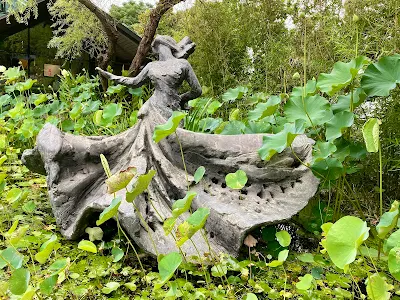
Walking from Cloud Gate Theater toward the city, you’ll see green rice fields and vegetable gardens, which makes me feel happy.
從雲門舞集往市區走,綠油油的稻田及一畦畦的蔬菜園,令人舒心愉悅。


Chi Po-lin Foundation 看見-齊柏林基金會
I really like Chi Po-lin’s work, and you can see some of it at the Chi Po-lin Foundation in Tamsui. Thanks to the generous support of thousands of people, the Chi Po-lin Museum was officially opened in 2019 in the rear building of Douglas Lapraik & Co. (No. 316-1, Zhongzheng Road, Tamsui). Through various themed exhibitions, visitors can explore the story of Taiwan’s land and environment.
我很喜歡齊柏林的作品,你可以在淡水「看見-齊柏林基金會」看到少許他的作品。經數千人的慷慨支持,「齊柏林空間」於 2019 年在淡水得忌利士洋行後棟(淡水中正路 316-1 號)正式開幕。透過各種主題展覽,遊客可以探索台灣土地與環境的故事。
Tamsui Red Castle 淡水紅樓
Tamsui Red Castle was originally built in 1895 by Li Yihe, a shipping merchant who made his fortune managing a foreign shipping company. The building was completed in 1899. However, after two of Li Yihe’s cargo ships were involved in accidents, he faced financial difficulties and was forced to sell the building to Hong Yinan, the head of Tamsui Street, in 1913.
Due to its commanding view, the Red Castle was renamed Taguan Building (meaning "tower with a view"). Later, it changed ownership again and, following renovations completed in 2000, was transformed into a restaurant and art gallery.
淡水紅樓原為經營洋船生意的船商李貽和於 1895 年建造,並於 1899 年落成。然而,李貽和的兩艘貨船發生事故後,李貽和陷入財務困境,於 1913 年被迫將紅樓出售給淡水街長洪以南。
紅樓因其居高臨下的視野,被重新命名為達觀樓。後來,它再次易主,並於 2000 年完成翻修,改建成了餐廳和藝文館。









There are many hidden gems to discover in the alleys of Tamsui.
淡水的巷弄間,常會隱藏著可參觀的地方。






Travel/Point of Interest Posts 旅遊景點帖子


Comments